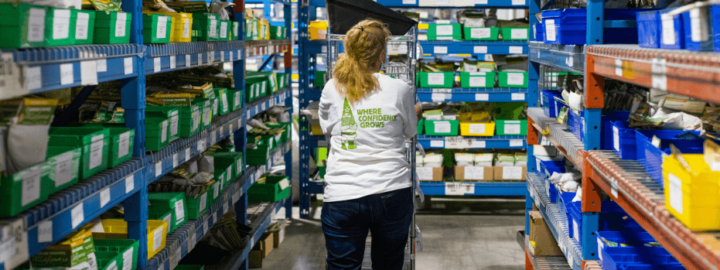
Why is Supply Chain Resilience Important?
As an owner or manager of a business that relies on supply chains, you’re well aware of the ongoing supply chain disruptions and the many reasons behind them—the pandemic, natural disasters, cyberattacks, the global chip shortage, trade tensions with China, the obstruction of the Suez Canal by the Ever Given, etc. Now, soaring inflation, the “Great Resignation,” and the invasion of Ukraine have put even more pressure on the already strained system, leading to higher prices, business closures, prolonged shortages of essential and non-essential goods and services, and more.
To remain a viable company in this challenging environment, you should focus on building supply chain resilience. But improving your supply chain is not a matter of making a few tweaks to your current strategy. It involves implementing multiple, often concurrent, strategies.
The Basics of Organizational and Supply Chain Resilience
Resilience is the ability to recover from a challenge, difficulty, or battle—not just once, but over and over again. The current supply chain volatility is a perfect example, and the following strategies can help you build supply chain resilience while insulating your business from long-term, negative impacts.
1. Create Supply Redundancies
If a business has created “supply redundancies,” that means it has gathered and is storing up more of the items it needs to produce its goods or services. This could include extra inventory, vital equipment, or the components to fix broken equipment. Such excess seems to fly in the face of popular lean production strategies, but, in reality, it ensures business continuity when unexpected situations strain companies’ ability to get necessary resources. Keep in mind, it’s not about having more of every resource—just having more of the right resources.
Though carrying costs and space limitations may pose a challenge, the ongoing supply chain disruptions have made it clear that the just-in-time (JIT) inventory strategy is not conducive to success in today’s supply chain environment.
2. Maintain Multiple Suppliers
Collaborating with a single supplier has its benefits, including strong relationships and cost incentives, but the supply chain disruptions have exposed the vulnerabilities of relying on one or two favored suppliers. Working with multiple suppliers creates more flexibility and fewer bottlenecks when shutdowns, shortages, and/or restrictions occur. And, if each supplier knows it’s not your only option, it may offer you competitive pricing and improved service.
3. Diversify Carrier Networks
The reasons for maintaining multiple suppliers hold true for diversifying carrier networks. Major shipping delays, which have been caused by increased demand and port lockdowns, have brought home the fact that relying on one or two main carriers does not work. If a carrier becomes incapacitated for any reason, your business is left scrambling for alternatives.
Businesses that contract with multiple shipping carriers (e.g., UPS, USPS, FedEx, or private carriers) are ready for whatever comes their way. An article by LJM Group, a parcel contract negotiating company, notes that the multi-carrier approach will “give you the power to more efficiently fulfill orders” and help you mitigate risk, remain competitive, accommodate customers, manage returns more effectively, and save on shipping costs.
4. Embrace Nearshoring
Nearshoring, also called “reshoring,” is the practice of decreasing dependence on international suppliers. The advantages of turning to a local supply chain model include:
- Reduced points of potential conflict or disruptions from unexpected events.
- Greater control over inventory.
- Closer proximity of producers and consumers.
- Reduced freight/shipping costs.
Forbes contributor Paul J. Noble considers nearshoring a feasible supply chain solution. He writes: “With great distances and no control over foreign government policies, U.S. companies and their supply chains suffered from offshore production strategies. The U.S.–China supply chain best represents why the concept of reshoring—placing production back in the U.S.—could be a favorable option for companies looking to heal their well-documented supply chain problems for the long term.”
5. Use Standardized Processes
Finally, supply chain resilience can be built by standardizing your production process and the parts you use to make your products. For example, replace unique components with standardized or generic parts, so, when it’s time to replace those parts, you’re not limited to a few specific suppliers.
Gartner calls this “product harmonization.” It “simplifies sourcing policies and creates opportunities to place higher volumes among multiple suppliers, which in turn enhances resiliency.”
Fostering a Culture of Resilience
The previous strategies and techniques for improving your supply chain are only effective if your entire team is on board. Managing disruptions is a whole-business effort. Keeping everyone informed about global and local events will prepare them for when disruptions inevitably arise and empower them to make strong decisions.
Implementing technology platforms that encourage communication, collaboration, and visibility across the organization can help keep your team organized, focused, and disciplined when disruptions come. Instead of blindly reacting, you and your teams will be able to see every aspect of the operation and adjust policies, procedures, and processes based on facts, not conjecture.
How Acumatica Can Help
In a recent article, Divya Ganesh, Acumatica’s Senior Director of Product Marketing, addresses how our cloud-based ERP solutions can help businesses in their quest for supply chain resilience. She writes:
[O]rganizations that implement a cloud-based ERP solution have set themselves up for supply chain success, even in uncertain times. For example, they now have:
- Planning and forecasting capabilities for managing inventories/resources, supplier deliveries, and production schedules.
- The information and flexibility necessary to adjust to changing circumstances.
- The ability to analyze data, assess operational constraints, and determine alternative solutions.
Though the 2021 supply chain challenges are significant, cloud ERP software allows businesses to evaluate and track inventory, material requirements, and logistics.
Acumatica is an award-winning cloud ERP solution that can improve your supply chain resilience. It acts as a central repository for business-wide data, providing a single source of real-time information. It also manages financials, reporting, CRM, inventory, payroll, and more through personalized dashboards that are accessible 24/7—whenever, from wherever.
For more information about Acumatica and our Distribution Edition software, contact our experts today.



















